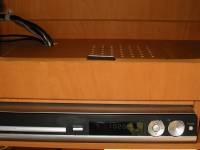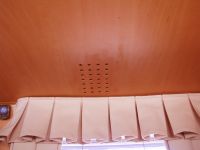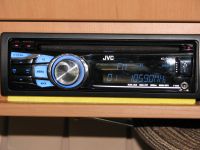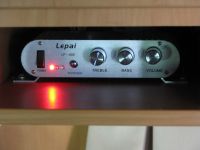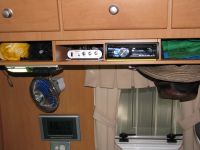
Entertainment System
I have changed both the television and the home theatre system in the Applause. The TV was an analog set to which I had added a set top box. The change simplified its use and halved the power demand. The home theatre system was a Philips unit and because it only ran off 230 V, was inconvenient to use. It was also a poor performer on radio. The change to a car CD tuner but using the already installed six speakers from the Philips unit has resulted in greatly improved performance and convenience with lower power consumption.
Television
The TV supplied with the Applause was a DSE Digitor Model G4321 with modes: analog TV, S-VIDEO, PC-VGA, and AV. The unit ran off 230 V AC via a power adaptor. It performed well; it would successfully run directly off the 12 V house battery but its power consumption was rather high at over 2 A. A digital Set Top Box added to the power consumption, totalling over 3 A.
I have replaced the DSE unit with a Kogan 16" LED TV with PVR, USB input and DVD player built in. It attaches to the same wall mount as the DSE. Power demand has dropped to under 1 A most of the time. However the sound quality is poor, and is greatly improved by connecting the TV sound output to the Philips HTS or replacement systems.
The wind-up AntennaTek antenna for the TV has received lots of attention. See here.
Philips Home Theatre System
 The
Philips Home Theatre System 3105/75 was fitted to the A'van Applause as standard.
It included DivX and MPEG1/2 DVD playback into the TV, MP3, WMA and PCM CD playback,
and AM/FM radio. Two Front, a Centre, two Rear and a Sub-Woofer under the bed made for
a complete setup.
The
Philips Home Theatre System 3105/75 was fitted to the A'van Applause as standard.
It included DivX and MPEG1/2 DVD playback into the TV, MP3, WMA and PCM CD playback,
and AM/FM radio. Two Front, a Centre, two Rear and a Sub-Woofer under the bed made for
a complete setup.
Its claimed maximum output was 500 W RMS but my tests showed normal volume levels consuming around 25–40 W (2–3 A). When powering the System from a 150 W cannister inverter the total consumption was always well over 2 A.
Radio Antennae
The Philips unit had separate FM and AM antenna sockets. The FM radio antenna socket was connected to the AntennaTek antenna and worked well enough so long as the antenna was elevated and its amplifier was on.
The AM radio antenna sockets of the Philips unit were connected to a loop antenna screwed to the back wall of Cupboard 2 (see cupboard shelves for naming convention). It was never going to work due to proximity of the steel skin of the Ducato. I replaced it with a stainless steel extendable antenna designed for mounting on a car window pillar, but here installed on the outside of the van. I cut off the antenna cable plug and connected the shield and core to the radio antenna sockets.
Ventilation
The Philips System was mounted below Cupboard 2 and would get quite warm. It had a small axial fan at the back to exhaust hot air, but the System had been installed with no ventilation. To mitigate this to some extent, I drilled a pattern of holes in the removable hatch over the unit. Problem is, these can get covered too easily by things in the cupboard. I also drilled holes in the base. This will allow some through flow.
JVC Car CD Tuner
The Philips unit was power hungry, inconvenient to use when not connected to 230 V, and gave exceptionally poor performance on AM and little better on FM radio.
I have replaced it with a JVC Car CD Tuner, bought for $149.00 from SuperCheap Auto. Keeping the Philips speakers in place, the JVC is able to provide stereo to the front and the back of the Applause, instead of the "surround sound" which never did work very well.
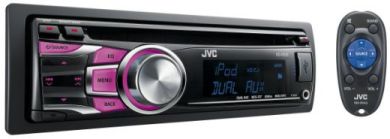
The unit is a KD-R526, chosen because it has
- Front AUX-IN for iPod and similar
- iPod connectivity with control from the JVC if wanted
- USB connectivity
- Rear AUX-IN for sound from the TV
- 2 x Rear line out for sub-woofer (requires an amplifier) and for centre speaker (also requires an amplifier)
- A remote controller.
The installation of the KD-R526 is described below. The unit makes good use of the added car radio antenna (the connection to the AntennaTek wind-up antenna for FM is not needed) and the ventilated area where the Philips HTS was located.
Performance of the KD-R526 is excellent. AM and FM sensitivities are really good, the sound is clean, and power consumption is less than 1 A most of the time, even when playing a CD. Standby current is approximately 3 mA.
Installation of the JVC Car CD Tuner

A twin 12 AWG cable has been run from the junction of the trunk cable in front of Cupboard 1 to the area of the KD-R526. Because there is also an Inverter in this circuit, I fitted a 10 A noise filter from Jaycar in the supply line, downstream from a 10 A in-line fuse. (The green wire from the noise filter is its 12 V input.)
The all-important key to the wiring colours for the KD-R526 is shown here in the Installation Instructions (631 kB). The red (12 V Ignition Switch) and yellow (12 V Battery) wires are joined and connected to the red wire from the noise filter. Black (ground) goes to a common point with the black wire from the noise filter, and an earth wire connected to the Ducato steel shell.
The wires from the Philips speakers were each labelled using white shrinkwrap and wired into an eight-pin Molex plug to mate with the socket wired from the KD-R526:
- Front speaker, left : white/white-black stripe
- Front speaker, right: gray/gray-black stripe
- Rear speaker , left : green/green-black stripe
- Rear speaker , right: purple/purple-black stripe
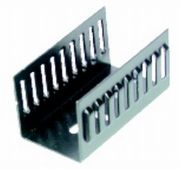
A 3.5 mm stereo mini-plug wired to a corresponding plug for the Kogan TV audio output is permanently plugged into the back of the KD-R526 and the sound can be selected as AUX-R from the "source" selector.
In operation, particularly at higher volumes, the rear aluminium heat sink of the KD-R526 gets quite hot. I have bolted an extra "U"-shaped heat sink to it, using heat transfer paste, to help cooling.
The SubWoofer and Centre Speakers
The JVC Tuner has on the back stereo RCA line-level output sockets for amplifiers for front and rear speakers. The rear speaker outputs can be reconfigured to alternatively drive a subwoofer with low-pass frequencies of 55Hz, 85Hz or 120Hz, with adjustable bass boost. It is this feature that I use here.
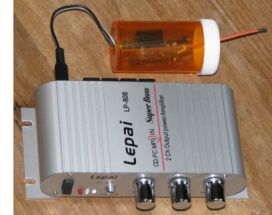
I am using a $15.00 Lepai stereo amplifier with super bass, model LP-808. From eBay Australia seller kucovi, it is a small 12V DC unit with maximum RMS output of 15W x 2. Here it is with the switched power connector (see below).
The RCA front speaker outputs from the JVC Tuner go to the right channel input of the Lepai and the RCA subwoofer speaker outputs from the JVC Tuner go to the left channel input of the Lepai; in both cases an RCA stereo to RCA mono cable is used. The Centre speaker and SubWoofer speakers are connected to the respective outputs of the Lepai.

A blue/white-stripe wire in the wiring harness of the JVC KD-R526 is designed to control an external amplifier. I have used this to drive a 3A SPDT mini relay to provide power to the Lepai only when the JVC Tuner is on. The relay takes 30mA. The circuit is housed in a plastic tablet bottle.
A schematic diagram of the power connections for the devices is given here for reference:

Retaining the Settings
The JVC Tuner is powered through the yellow wire. In a normal installation, the ignition switch controls the state of the Tuner through the red wire. With ignition off, the current consumption drops to about 3.5 mA in about 20 s after first dropping to about 200 mA. This current is used to retain the settings in the Tuner.
In the present installation, all power comes via the circuit breaker in the Technical Cupboard and if the circuit breaker is switched off, the settings in the JVC Tuner would be lost. A simple circuit overcomes this problem. In the "off" state the current consumption is so low that it can easily be supplied by a 9 V battery. The circuit is here:

The circuit uses a P6006 diode, a 6.8 A power diode (left over from solar panel changes), in the main supply path and a 1N483 diode, a 600 mA diode (junk box), from the 9 V battery. With the supply off because of the circuit breaker or an absent house battery, the JVC Tuner receives standby power from the 9 V battery. Any attempt to turn on the Tuner will fail because the red wire is unconnected.
It is important to turn off the KD-R526 and wait about 20 s before turning the circuit breaker off. Otherwise, the Tuner will not properly enter the standby state and the current draw from the 9 V battery will be about 200 mA.
Here is the circuit as built. It plugs into the wiring for the JVC Tuner using automotive bullet crimp connectors
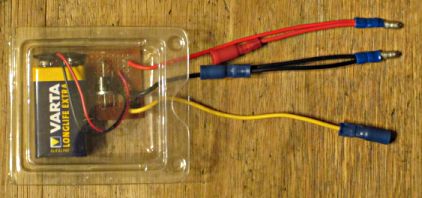
LINKS
- A'van http://www.avan.com.au
- Jaycar http://www.jaycar.com.au
- JVC http://www.jvc.com.au/car-av
- Philips http://www.philips.com.au
AV Setup
The 16" Kogan TV on swivel mount in the Applause.
A pattern of holes was drilled above the Philips system to allow some air circulation.
A pattern of holes was also drilled under the Philips system to allow some air circulation.
A car radio antenna was fitted to the side for AM radio reception.
The JVC KD-R526 CD Tuner installed below Cupboard 2.
The LP-808 amplifier drives the Centre and SubWoofer speakers from the JVC CD Tuner.
The JVC CD Tuner and SubWoofer amplifier installed in the Applause.

